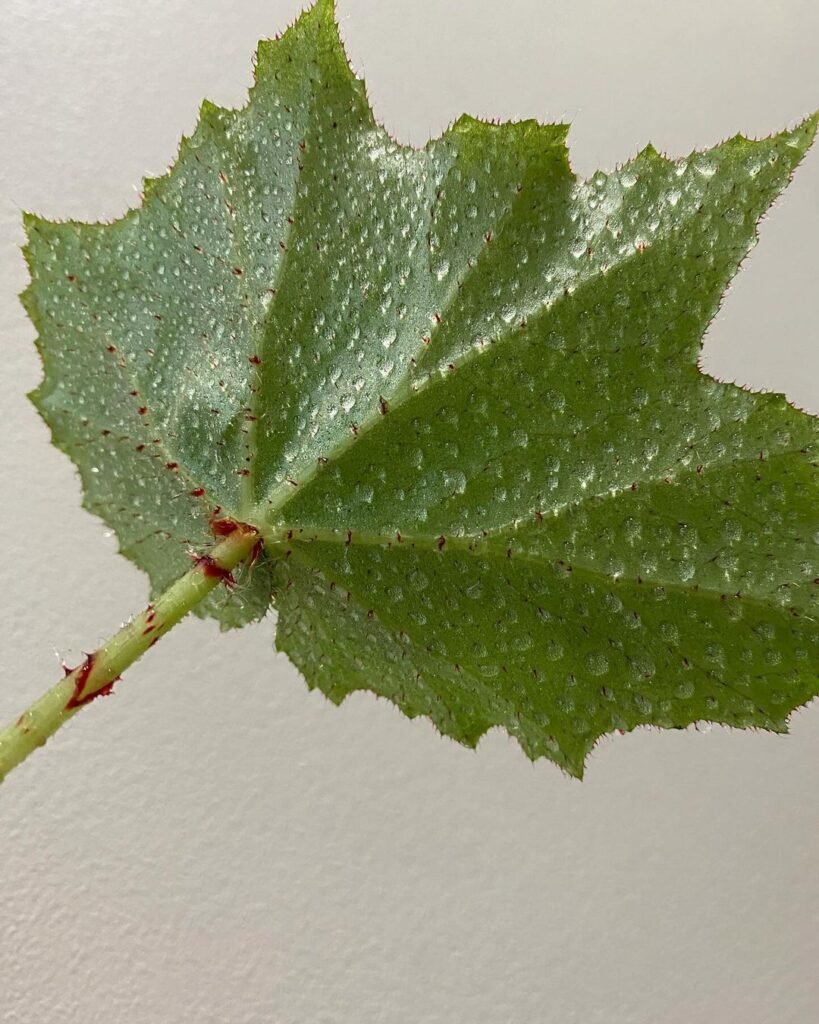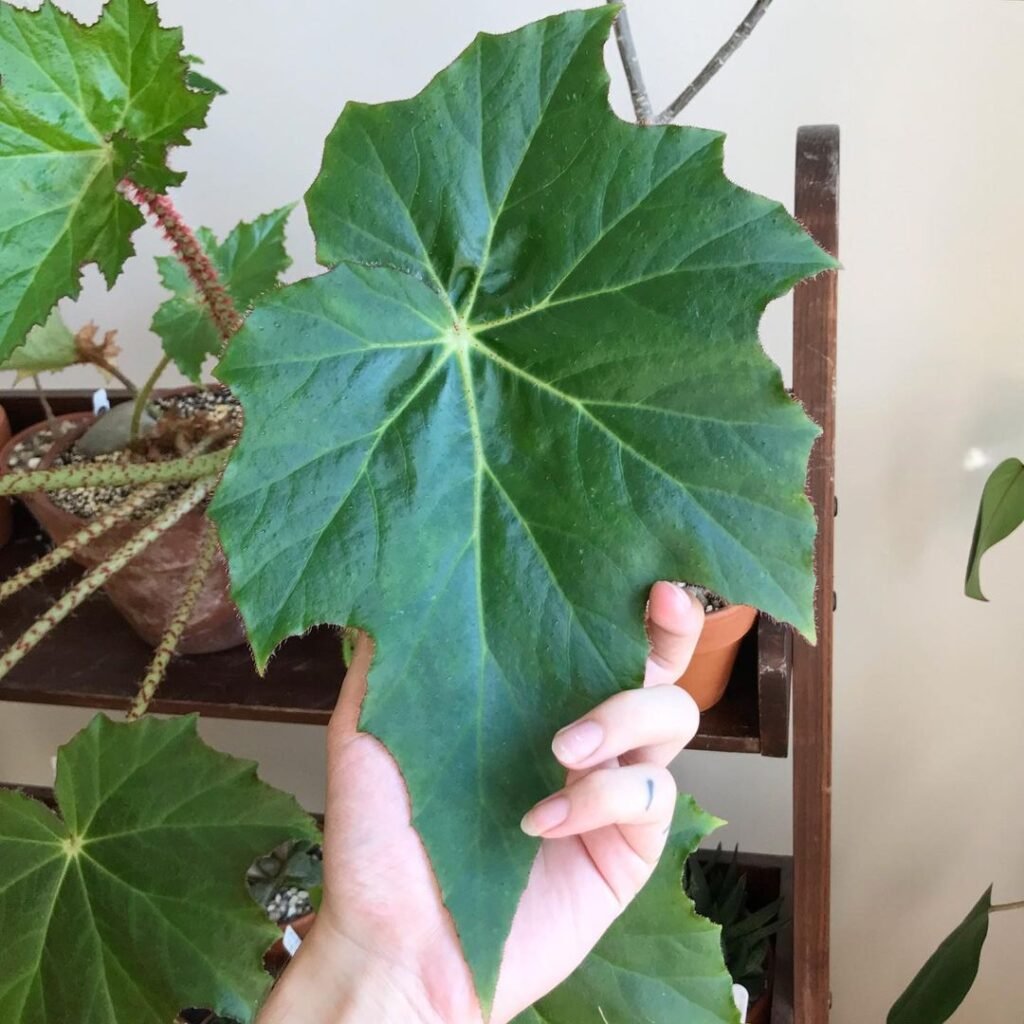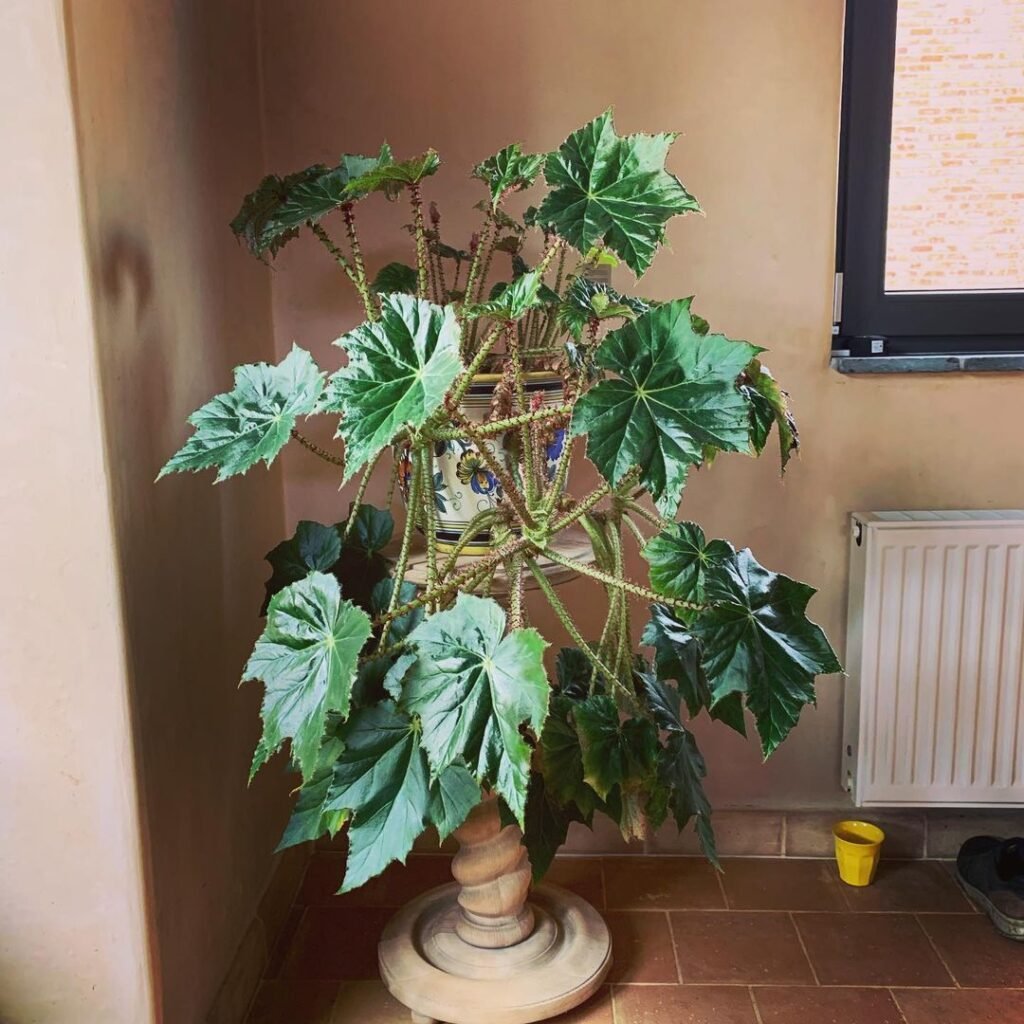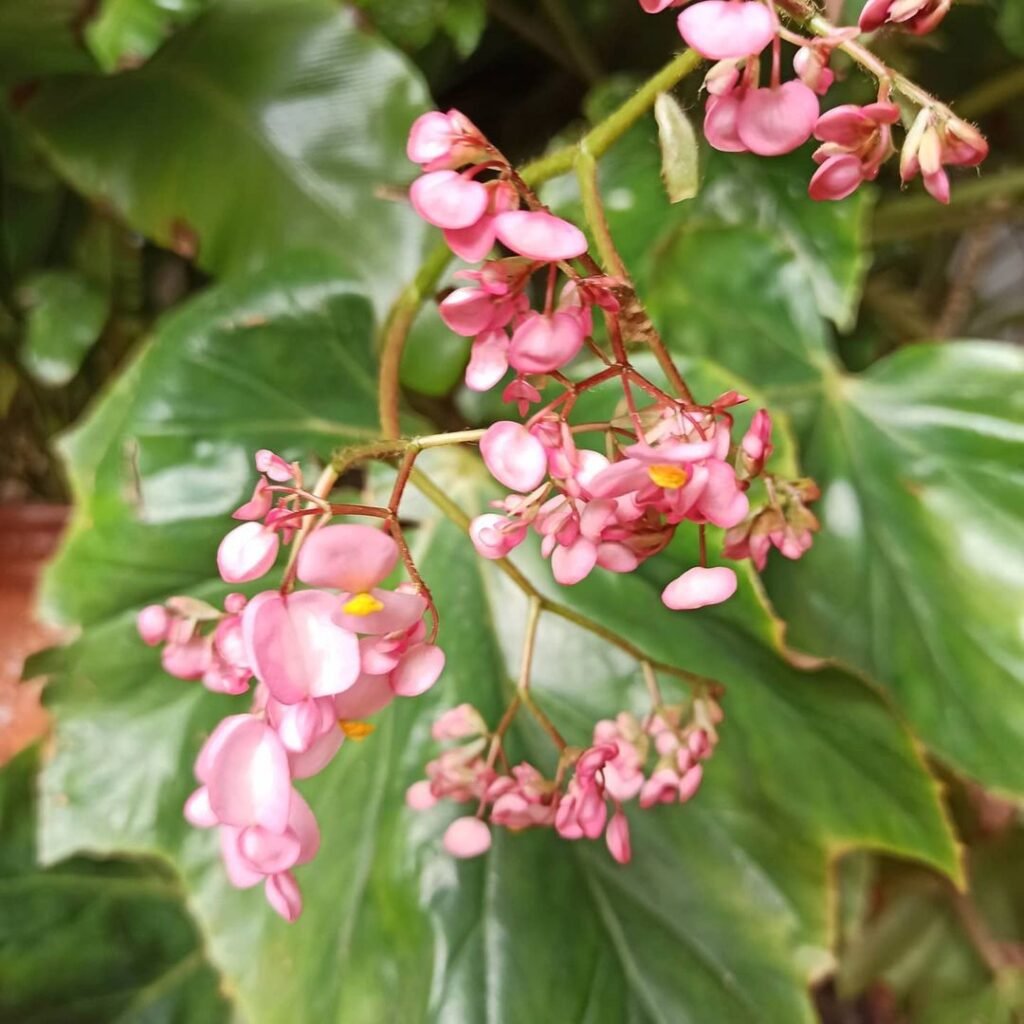Begonia Immense is a striking plant known for its lush foliage and unique characteristics. Belonging to the Begoniaceae family, this plant has captured the attention of both seasoned gardeners and beginners alike.
With its botanical name being Begonia Immense, this plant boasts distinctive features that set it apart from other begonia varieties.
Key Features of Begonia Immense:
- Leaves: The leaves of Begonia Immense are large, asymmetrical, and often display vibrant colors, ranging from deep greens to shades of red and silver patterns.
- Size: As the name suggests, Begonia Immense can grow to impressive sizes, making it a focal point in gardens or indoor spaces.
- Blossoms: While not primarily grown for its flowers, Begonia Immense may produce small, delicate blooms in clusters, enhancing its overall visual appeal.
Ideal Growing Conditions:
For optimal growth, Begonia Immense thrives in well-draining soil and prefers partial shade. Understanding its basic characteristics lays the foundation for successful cultivation and care.



Begonia Immense Care Guide Overview
When embarking on the journey of nurturing a Begonia Immense, it’s crucial to grasp the essentials of its care. Let’s delve into a comprehensive overview to ensure your Begonia Immense thrives in its environment.
Begonia Immense Care at a Glance:
| Aspect | Requirement |
|---|---|
| Light | Indirect sunlight or partial shade |
| Soil | Well-draining, rich soil |
| Watering | Moderate, keeping soil consistently moist |
| Humidity | High humidity, mimicking its native tropical habitat |
| Temperature | 65-75°F (18-24°C) |
| Fertilization | Balanced liquid fertilizer during the growing season |
| Pruning | Periodic pruning to shape and maintain size |
Additional Tips:
- Light Requirements: Place Begonia Immense where it receives filtered sunlight to prevent leaf scorching.
- Watering Routine: Keep the soil consistently moist but avoid overwatering to prevent root rot.
- Humidity Management: Use a humidity tray or mist the plant regularly to maintain the required humidity level.
By adhering to these fundamental care guidelines, you set the stage for a flourishing Begonia Immense.
Genus Species & Appearance



Understanding the Genus Species and appearance of Begonia Immense provides valuable insights into its botanical origins and visual characteristics.
Genus and Species:
The genus for Begonia Immense is, as mentioned earlier, Begonia, a diverse genus with over 1,800 known species. The species name, Immense, reflects its notable size and grandeur. This classification aids in categorizing and identifying the plant accurately.
Visual Appearance:
- Leaves: The large, asymmetrical leaves of Begonia Immense often showcase intricate patterns and vibrant colors, making it an aesthetically pleasing addition to any plant collection.
- Stems: The sturdy stems contribute to the plant’s overall robustness, supporting its impressive size.
- Blooms: While not the main attraction, Begonia Immense may produce small, delicate flowers in various colors, adding a subtle touch of elegance.
By familiarizing yourself with the genus, species, and visual aspects of Begonia Immense, you deepen your connection with this captivating plant and enhance your ability to provide tailored care.
Not the plant for you? Check out my full list of 78 Types of Begonia!
Begonia Immense Light and Soil Requirements



Understanding the specific light and soil requirements for Begonia Immense is crucial to ensure its optimal growth and vibrant appearance.
Light Conditions:
Begonia Immense thrives in indirect sunlight or partial shade. While it can tolerate some direct sunlight, it’s essential to shield it from harsh afternoon rays. Placing it near a window with filtered light or providing dappled sunlight outdoors creates an ideal environment.
Soil Composition:
The soil for Begonia Immense should be well-draining and rich in organic matter. A mix of potting soil, perlite, and peat moss provides the necessary aeration and moisture retention. Regularly check the soil’s moisture level, ensuring it remains consistently moist without becoming waterlogged.
Tip: Rotate the plant periodically to promote even growth on all sides, as Begonia Immense tends to lean towards the light source. This ensures a balanced and well-shaped specimen.
Watering Begonia Immense

Proper watering of Begonia Immense is a key factor in its care, as this plant thrives in consistently moist conditions without being waterlogged.
Watering Routine:
Begonia Immense prefers moderate watering, keeping the soil consistently moist. Allow the top inch of the soil to dry out slightly between waterings to prevent overwatering. Water directly at the base of the plant to avoid wetting the leaves, which can lead to fungal issues.
Signs of Overwatering:
- Yellowing Leaves: If the leaves turn yellow and feel mushy, it indicates overwatering.
- Wilting Despite Moist Soil: Overwatered Begonia Immense may exhibit wilting, even though the soil is still wet.
Tip: Use a watering can with a narrow spout or a drip irrigation system to control water distribution, preventing accidental overwatering. Adjust the watering frequency based on the environmental conditions and the plant’s specific needs.
Begonia Immense Humidity and Temperature



Creating the right humidity and temperature conditions is essential to mimic Begonia Immense’s native tropical habitat and promote vigorous growth.
Humidity Requirements:
Begonia Immense thrives in high humidity. To increase humidity around the plant, place a tray filled with water and pebbles nearby or mist the leaves regularly. This helps prevent leaf drying and promotes a lush, vibrant appearance.
Temperature Range:
Maintain a temperature range of 65-75°F (18-24°C) for Begonia Immense. Avoid exposing it to drafts or sudden temperature fluctuations, as this can stress the plant. If grown outdoors, provide protection during cooler nights or extreme weather conditions.
Tip: During the winter months, consider using a humidifier to maintain consistent humidity levels, especially if the indoor air tends to be dry. This extra moisture is beneficial for Begonia Immense’s overall well-being.
Fertilizing Begonia Immense

To maintain the vibrancy and health of your Begonia Immense, a well-thought-out fertilization routine is crucial. The choice of fertilizer and the timing of application directly impact the plant’s growth and flowering capabilities.
Fertilization Schedule:
Understanding the specific needs of Begonia Immense throughout its growth cycle is essential. Here’s a detailed breakdown of the fertilization schedule:
| Stage | Fertilizer Type | Frequency |
|---|---|---|
| Early Growth | Balanced liquid fertilizer | Every 2 weeks |
| Mid-Growth | Balanced liquid fertilizer | Every 3 weeks |
| Blooming Season | High-phosphorus liquid fertilizer | Every 4 weeks |
| Dormant Season | Diluted or slow-release fertilizer | Once a month |
This table provides a comprehensive guide to adjusting your fertilization routine based on the specific developmental stages of Begonia Immense.
Begonia Immense Pruning and Shaping
Pruning and shaping Begonia Immense not only enhances its aesthetic appeal but also contributes to its overall well-being. Adopting the right techniques ensures a balanced and healthy plant.
Pruning Guidelines:
- Remove Dead or Yellowing Leaves: Regularly inspect your Begonia Immense for any signs of disease or aging leaves. Prune away dead or yellowing foliage to encourage new growth and maintain a tidy appearance.
- Control Size: If your Begonia Immense starts to outgrow its designated space, trim back overly long stems. This not only helps in managing the size but also encourages branching for a fuller look.
- Pinch for Bushiness: To encourage a bushier and more compact growth habit, pinch the tips of the stems. This simple technique diverts the plant’s energy into lateral shoots, resulting in a fuller appearance.
Shaping Techniques:
Experimenting with different shaping techniques allows you to customize the look of your Begonia Immense. Whether you prefer a compact, rounded form or a more cascading and sprawling appearance, strategic pruning helps achieve the desired shape.
Begonia Immense Propagation and Repotting
The processes of propagation and repotting play a vital role in the life of Begonia Immense. These activities allow you to expand your plant collection and maintain the health of your existing specimens.
Propagation Methods:
Understanding the various propagation methods gives you options to propagate Begonia Immense based on your preferences and the plant’s condition:
- Leaf Cuttings: Take leaf cuttings during spring or early summer, ensuring each cutting has a healthy vein attached.
- Rhizome Division: During repotting, divide the rhizomes carefully, ensuring each section has viable roots and shoots.
- Stem Cuttings: Opt for stem cuttings in the spring or summer, selecting healthy stems with at least a few nodes.
Repotting Guidelines:
- Frequency: Aim to repot Begonia Immense every 1-2 years or when it outgrows its current container. This helps refresh the soil and provides the plant with fresh nutrients.
- Well-Draining Soil: Use a well-draining potting mix to prevent waterlogging, ensuring optimal aeration for the roots.
- Inspect Roots: During the repotting process, take the opportunity to inspect the roots. Trim any rotting or dead roots and check for signs of overcrowding.
Begonia Immense Seasonal Care
Adapting your care routine based on the changing seasons is crucial for the well-being of Begonia Immense. Understanding the plant’s needs during different seasons ensures it thrives year-round.
Spring:
- Pruning and Refreshing Soil: As the growing season begins, prune any winter-damaged or leggy growth. Consider refreshing the soil with a well-balanced, slow-release fertilizer to kickstart the growth.
- Propagation Opportunity: Spring is an ideal time for propagation. Take advantage of the active growth phase to propagate Begonia Immense through stem or leaf cuttings.
- Monitor for Pests: With the arrival of warmer temperatures, keep a vigilant eye for pests like aphids or spider mites. Early detection allows for prompt intervention.
Summer:
- Optimal Light Conditions: Ensure Begonia Immense receives filtered sunlight during the summer months. If grown outdoors, provide shade during the hottest part of the day to prevent leaf scorch.
- Consistent Watering: Summer often brings higher temperatures, so maintain consistent soil moisture. Adjust the watering frequency to prevent the soil from drying out completely.
- Fertilize Regularly: With increased growth, continue fertilizing every 3-4 weeks using a balanced liquid fertilizer to support the plant’s nutritional needs.
Fall:
- Reduced Watering: As temperatures start to cool, reduce watering to prevent waterlogged soil. Allow the top layer to dry slightly between waterings to accommodate the plant’s natural slowdown.
- Prepare for Dormancy: In preparation for dormancy, reduce fertilization frequency. Trim back any excessive growth and consider moving potted Begonia Immense indoors if temperatures drop significantly.
- Inspect for Diseases: Before the onset of winter, inspect the plant for signs of diseases or pests. Treat any issues before the dormant season to ensure a healthy plant come spring.
Begonia Immense Companion Plants
Choosing suitable companion plants enhances the visual appeal of your garden and provides a supportive environment for Begonia Immense. Consider plants that share similar light and moisture requirements for a harmonious combination.
Suitable Companions:
| Companion Plant | Characteristics |
|---|---|
| Ferns | Lush foliage, complements large, textured leaves |
| Hostas | Varied leaf shapes and colors, contrasts with Begonia |
| Caladiums | Vibrant, colorful leaves, adds a pop of color |
Planting Tips:
- Consider Height Variations: Arrange companion plants based on their height, with taller plants providing shade to Begonia Immense if needed.
- Mind Watering Needs: Select plants with similar water requirements to simplify your watering routine and ensure all plants thrive.
- Aesthetic Harmony: Aim for a visually pleasing combination by choosing plants with contrasting or complementary colors and leaf shapes.
By strategically selecting companion plants, you create a cohesive and visually appealing garden that complements the unique features of Begonia Immense.
If you’re thinking of extending your begonia plant family, I recommend reading up on begonia sinbad and begonia odorata. They both make great additions to your squad!
Pest Control Tips for Begonia Immense
Maintaining a healthy Begonia Immense involves proactive pest control measures. Identifying and addressing pest issues promptly is essential to prevent damage to the plant.
Common Pests:
- Aphids: These small, sap-sucking insects can cluster on the undersides of leaves, causing distortion and discoloration.
- Spider Mites: Tiny arachnids that create fine webs on the foliage, leading to stippling and yellowing of leaves.
- Mealybugs: Cottony, white insects that feed on plant sap, often hiding in leaf axils and other protected areas.
Pest Control Methods:
- Neem Oil: A natural insecticide, neem oil is effective against a variety of pests. Dilute it according to the instructions and apply to the foliage.
- Insecticidal Soap: Use a mild insecticidal soap to control soft-bodied pests like aphids and mealybugs. Ensure thorough coverage, especially on the undersides of leaves.
- Beneficial Insects: Introduce beneficial insects, such as ladybugs or predatory mites, to naturally control pest populations.
Prevention Tips:
- Regular Inspection: Routinely inspect your Begonia Immense for signs of pests. Early detection allows for swift intervention before infestations become severe.
- Isolate New Plants: Quarantine new plants before introducing them to your collection to prevent the spread of potential pests.
- Maintain Plant Health: Healthy plants are less susceptible to pest infestations. Ensure proper care practices, including watering, fertilizing, and providing optimal growing conditions.
Reviving a Sick or Wilting Begonia Immense
When your Begonia Immense is showing signs of distress, quick intervention can often revive the plant to its former glory. The first step is to identify the root cause of the issue.
Check for overwatering, underwatering, or pest infestations. If the soil is waterlogged, adjust your watering routine, allowing the top layer to dry out between waterings. If pests are the culprit, implement appropriate control measures, such as neem oil or insecticidal soap.
Trim away any diseased or yellowing leaves, and consider repotting if root rot is detected. Providing optimal growing conditions and addressing issues promptly can help nurse your Begonia Immense back to health.
Tip: When reviving a sick Begonia Immense, avoid drastic changes. Gradually adjust watering, lighting, or fertilization to prevent additional stress on the plant.
Conclusion
In conclusion, cultivating and caring for Begonia Immense can be a rewarding experience for any plant enthusiast. From understanding its unique characteristics to tailoring care routines for each season, the key lies in attentive and proactive care.
Whether you’re a seasoned gardener or a beginner, the versatility and beauty of Begonia Immense make it a captivating addition to any indoor or outdoor space. By incorporating the provided guidelines and tips into your care routine, you’ll likely witness your Begonia Immense thriving and flourishing.
FAQs
Is Begonia Immense suitable for beginners?
Begonia Immense can be suitable for beginners with a willingness to learn and adapt. While it has specific care requirements, understanding its needs and providing consistent care can lead to a successful cultivation experience.
Can Begonia Immense tolerate direct sunlight?
While Begonia Immense prefers indirect sunlight or partial shade, it can tolerate some direct sunlight. However, it’s crucial to protect it from intense afternoon rays, as excessive exposure can lead to leaf scorching.
How often should I fertilize Begonia Immense during the growing season?
During the growing season, fertilize Begonia Immense every 2-4 weeks using a balanced liquid fertilizer. Adjust the frequency based on the plant’s response and environmental conditions.
What is the ideal temperature range for Begonia Immense?
Begonia Immense thrives in temperatures between 65-75°F (18-24°C). Avoid exposing it to drafts or sudden temperature fluctuations, as this can stress the plant.
Can I grow Begonia Immense indoors?
Yes, Begonia Immense can be grown indoors, provided it receives adequate indirect sunlight and high humidity. Ensure well-draining soil and consider using a humidity tray or misting the plant to maintain optimal conditions.
How do I prevent pest infestations on Begonia Immense?
To prevent pest infestations, regularly inspect the plant for signs of pests, isolate new plants before introduction, and maintain overall plant health. Introducing beneficial insects, such as ladybugs, can also aid in natural pest control.

Writer/Green Thumb/Explorer – Rooted deep in the rich soils of Devon, I’ve cultivated a vast expertise in plant care, helping greenery thrive in homes across the UK. When I’m not crafting detailed plant care guides, I’m journeying through the lush landscapes of the West Country, unearthing nature’s secrets and sharing them with fellow plant enthusiasts. Every leaf has a story, and I’m here to tell it.





